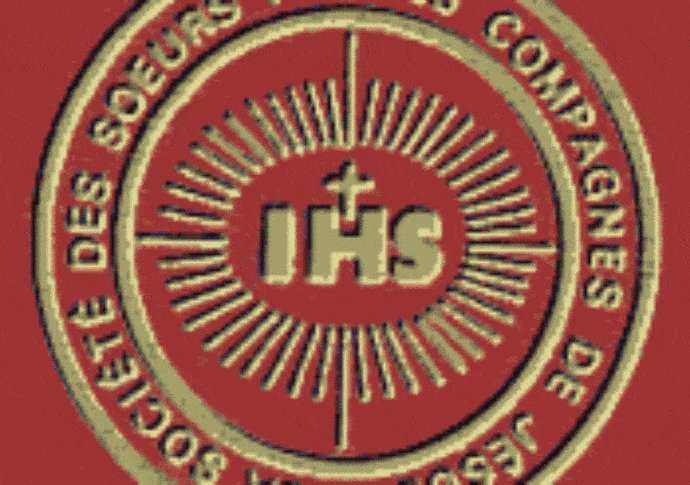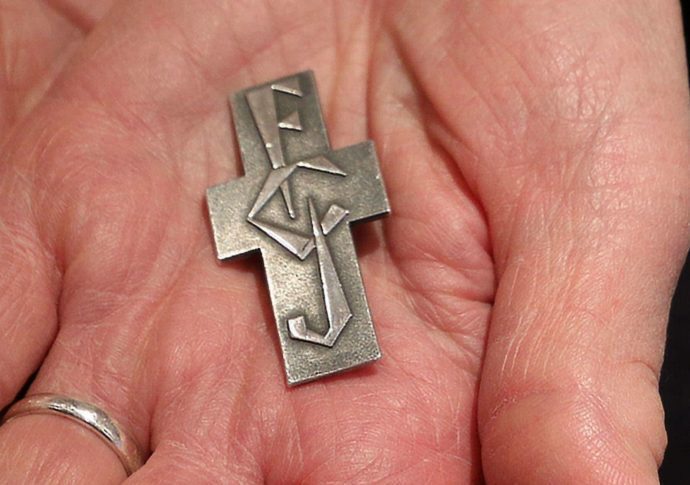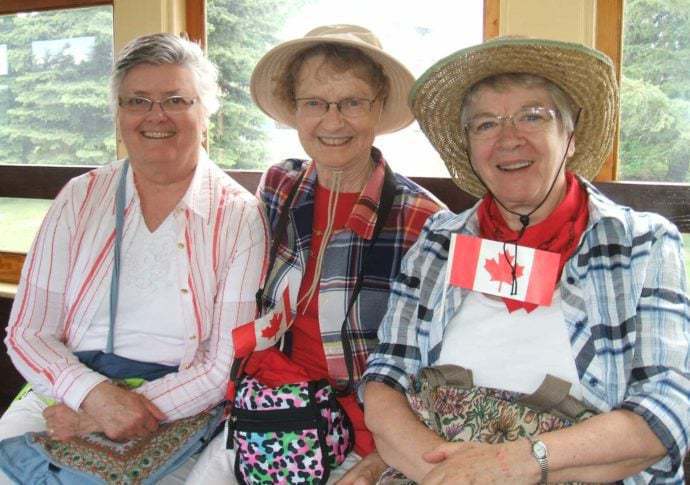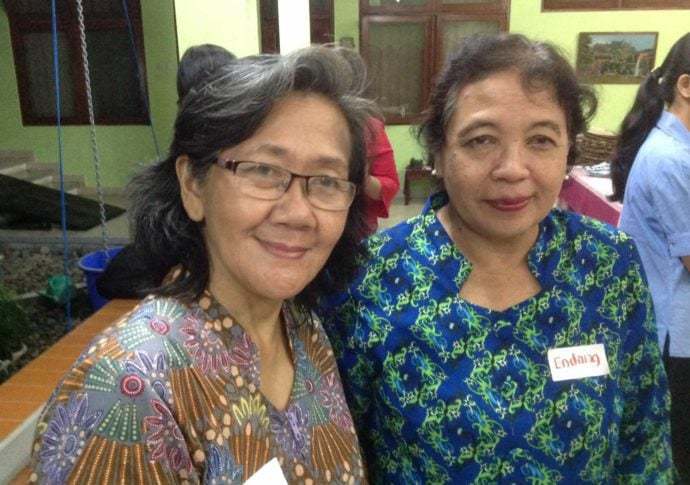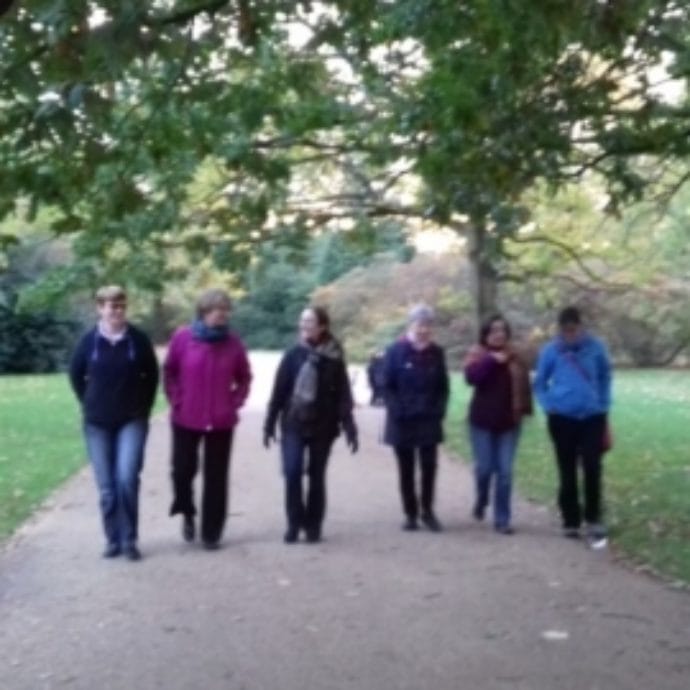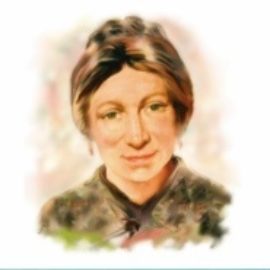History of the Faithful Companions of Jesus in Britain and the Channel Isles

History of the Faithful Companions of Jesus in Britain and the Channel Isles
Beginnings - FCJ Sisters arriving in England
Marie Madeleine d’Houët, Foundress of the sisters Faithful Companions of Jesus, and Sr Julie Guillemet arrived to the French émigré parish in Somers Town, London, in 1830. It was from these beginnings, often fraught with difficulty but sustained by great courage, determination and desire for God’s glory, that a very fruitful mission developed in England, Scotland and the Channel Isles.
Marie Madeleine d’Houët, the Foundress, and Julie Guillemet arrived in London in November 1830, with a letter of introduction to Fr Nerinckx, who was in charge of the émigré parish in Somers Town. The day after their arrival, he invited them to accept the schools that had already been established. They were welcomed by Thomas Griffiths VA London District. The address then was St Aloysius, Clarendon Square, Somers Town N.W. A new convent was erected on the site in 1972 by which time the street address had become Phoenix Road.


L: The Polygon and St Aloysius Church, Clarendon Square, Somers Town c.1850 based on a sketch by Joseph Swain. R: Map c.1830 showing Clarendon Square, Somers Town.
‘Yesterday when you arrived,’ Father Nérinckx explained to them, ‘I was immediately convinced that you were the persons we had been waiting for. My sister thought as I did, and all the personnel here are likewise convinced. In this house, besides my sister and myself, there are eight young assistants, all of whom wish to become religious. The furniture of the house belongs to us. We have no debts and we have more than 100,000 francs in the bank. I wish to offer all to you; I only ask that you accept it. My sister and her young associates wish to join you …’
It was from these beginnings, often fraught with difficulty but sustained by great courage, determination and desire for God’s glory, that a very fruitful mission developed in England, Scotland and the Channel Isles.
A clear need in those early days was education, especially the education of the poor, both children and adults. As the years went by, numerous schools were established by the sisters, and many of them flourished. Since the sisters held that faith development was at the heart of their work of education, spiritual retreats were always offered to pupils in their schools and to the people in the local parishes. For more than 150 years, teaching in schools (parish schools as well as their own foundations), together with the organising of retreats, was the hallmark of the FCJ apostolate in England, Scotland and the Channel Isles.
London, Somers Town 1830
 The FCJ Sisters have ministered in and around Somers Town since 1830. They have been involved in a variety of ministries. Maria Fidelis Convent School has continuity with the school that had been established by Abbé Carron in 1795 before the arrival of the FCJ sisters. The Sisters taught in St Aloysius parish school for over 160 years.
The FCJ Sisters have ministered in and around Somers Town since 1830. They have been involved in a variety of ministries. Maria Fidelis Convent School has continuity with the school that had been established by Abbé Carron in 1795 before the arrival of the FCJ sisters. The Sisters taught in St Aloysius parish school for over 160 years.
Early history of St Aloysius' Convent School, Somers Town, London
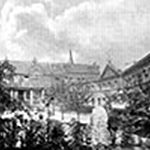
"Where did she first set foot?" by Helen Downe fcJ

London, Tottenham 1835-1853
In 1835 Fr Nerinckx extended his charity schools from Somers Town (q.v.) to Tottenham, a mission which had been founded in 1794 by another émigré priest, Abbé Cheverus. The FCJs went with him to serve the Poor Schools opened for the mostly seasonal Irish who worked as market gardeners and field workers. The sisters lived in White Hart Lane, Tottenham until fire destroyed the house in 1853. It was not rebuilt.
London, Hampstead 1839-1853
This was a mission which had been founded in 1756 by a French émigré priest, Abbé Jean-Jacques Morel. The address was Church Row, Hampstead. The sisters continued their work according to the same plan as in Somers Town (q.v) and Tottenham.
London, Gumley House, Isleworth 1841-
Marie Madeleine bought Gumley House, Isleworth in 1841. Her primary intention was to open a First Class Boarding School with a view to providing future members for the Society. The House had been built in 1700 by John Gumley. Gumley House is now the Generalate of the Sisters Faithful Companions of Jesus and site of Gumley House School FCJ.




The History of Gumley House, Isleworth, London

Gumley House Cemetery and Miss Willmott’s Ghost, by Mary Brown

Liverpool Great George Square and Bellerive 1844 –

The Foundress sent Sisters to Liverpool in 1844, at the invitation of Fr Parker, whose parish, St Patrick’s, had been opened expressly for Irish immigrants. Some sisters worked in the parish schools, and others established a boarding school. In 1887 the school and community moved from 2 Great George’s Sq to (Mount St Joseph’s), Bellerive, Princes Park. In 1968 the whole of the Bellerive building was taken over by the school, Bellerive FCJ Catholic College, and the community moved into the former Anglican Convent, St Gabriel’s, on Windermere Terrace, keeping the name Bellerive Convent. In 1997 a smaller community group moved to York Avenue.
'Devotedness and Love' by Sr. Mary Campion McCarren fcJ

Wirral, Lingdale, Upton Hall 1849-1998

Lingdale House, leased from 1849, was the first FCJ convent in Cheshire. When the lease expired in 1863, the Community and boarding school moved to Upton Hall. In 1951 Upton Manor was purchased; in 1983, 49 Manor Drive was bought for the convent and Upton House Convent was transferred to the School. The last members of Community left Upton in 1998.
A Mine of Gold, by Mary Campion McCarren fcJ

Birkenhead, Holt Hill Convent and School 1852-
 At the invitation of Dr James Brown, First Bishop of Shrewsbury, in 1852 the Foundress opened a community in Birkenhead, daughter house of Lingdale (q.v.). His request was for a school for the mercantile class which was growing in Birkenhead as well as for care of the Parish Schools. Before moving to Tranmere Hall, Holt Hill in 1857, the sisters lived at Hampden House, Hampden Street, near the Catholic Chapel from 1852, and then at Hamilton Square from 1854. The first recorded Baptism of St Joseph’s parish was recorded as taking place in Holt Hill Convent Chapel in 1898. In 1941 the community was evacuated to Upton Hall, but kept its own identity. With the New Education Act of 1944 Holt Hill was recognised as a direct grant grammar school. The school regime was considered strict but fair and provided excellent employment opportunities with local employers. The sisters ceased their involvement in the school in the late 70s. In 1976 the sisters moved to Heathbank Road in St Joseph’s parish. In 1982 a last mass was celebrated in Holt Hill prior to the demolition of the Convent to make way for a housing estate. The large Crucifix from Holt Hill chapel was donated to St Joseph’s parish and can now be seen suspended above the High Altar. The stained glass windows now adorn St. Pauls on the Ford Estate.
At the invitation of Dr James Brown, First Bishop of Shrewsbury, in 1852 the Foundress opened a community in Birkenhead, daughter house of Lingdale (q.v.). His request was for a school for the mercantile class which was growing in Birkenhead as well as for care of the Parish Schools. Before moving to Tranmere Hall, Holt Hill in 1857, the sisters lived at Hampden House, Hampden Street, near the Catholic Chapel from 1852, and then at Hamilton Square from 1854. The first recorded Baptism of St Joseph’s parish was recorded as taking place in Holt Hill Convent Chapel in 1898. In 1941 the community was evacuated to Upton Hall, but kept its own identity. With the New Education Act of 1944 Holt Hill was recognised as a direct grant grammar school. The school regime was considered strict but fair and provided excellent employment opportunities with local employers. The sisters ceased their involvement in the school in the late 70s. In 1976 the sisters moved to Heathbank Road in St Joseph’s parish. In 1982 a last mass was celebrated in Holt Hill prior to the demolition of the Convent to make way for a housing estate. The large Crucifix from Holt Hill chapel was donated to St Joseph’s parish and can now be seen suspended above the High Altar. The stained glass windows now adorn St. Pauls on the Ford Estate.
A Mine of Gold, by Mary Campion McCarren fcJ

Salford, Adelphi House, Marple Bridge and Monton 1852-1981
 Canon Wilding and Bishop William Turner, first Bishop of Salford, having heard of the work done by the FCJs in London and Liverpool, invited Marie Madeleine, the FCJ Foundress, in 1852, to send sisters to take over the Cathedral Elementary School, Upper Cleminson Street. The sisters lived at Adelphi House, The Crescent, which had previously belonged to the Leeming family. They established a Secondary School which, in the Diocesan re-organization was amalgamated with Sacred Heart School in 1977 and later became part of Cathedral High School.
Canon Wilding and Bishop William Turner, first Bishop of Salford, having heard of the work done by the FCJs in London and Liverpool, invited Marie Madeleine, the FCJ Foundress, in 1852, to send sisters to take over the Cathedral Elementary School, Upper Cleminson Street. The sisters lived at Adelphi House, The Crescent, which had previously belonged to the Leeming family. They established a Secondary School which, in the Diocesan re-organization was amalgamated with Sacred Heart School in 1977 and later became part of Cathedral High School.
St Joseph’s Convent, Marple Bridge, which was run from Adelphi House, was founded in 1900 in Hollins Lane, as a ‘country house’ for the sisters. It moved in 1929 to Millbrow where there was a small day school. It closed in 1932. In 1929 Monton House, Eccles was bought as a prep school for Adelphi.
Adelphi House Convent, the School by the Irwell 1852-1981 by Sr Frances Heaton fcJ

The FCJ Sisters' contribution to the Diocese of Salford, by Mary Campion McCarren fcJ

Manchester: Upper Brook St, Fallowfield, Withington and The Hollies, Didsbury Chorlton-On-Medlock 1853-1989
 The Community in Manchester moved several times and is commonly referred to as The Hollies. Initially a development from Adelphi House, Salford, in 1853 the sisters were at 130 Upper Brook Street. From 1900-1907 they lived in Oak Road, Withington. In 1908, they moved to The Hollies, Oak Drive, Fallowfield, where they remained until 1961. They then moved to The Hollies, Mersey Road, Fielden Park, Manchester 21, where they stayed until 1989.
The Community in Manchester moved several times and is commonly referred to as The Hollies. Initially a development from Adelphi House, Salford, in 1853 the sisters were at 130 Upper Brook Street. From 1900-1907 they lived in Oak Road, Withington. In 1908, they moved to The Hollies, Oak Drive, Fallowfield, where they remained until 1961. They then moved to The Hollies, Mersey Road, Fielden Park, Manchester 21, where they stayed until 1989.
History of the Hollies Convent FCJ

Chester, Dee House 1854-1925
 Dee House, on the site of an ancient monastery and, as transpired later, of a Roman amphitheatre, had been bought by local Catholics, and in 1854 Bishop Brown asked for a foundation from Lingdale House (q.v.) to open a boarding school and teach girls and infants in the parish schools where there were large numbers of immigrants driven from Ireland by the famine.
Dee House, on the site of an ancient monastery and, as transpired later, of a Roman amphitheatre, had been bought by local Catholics, and in 1854 Bishop Brown asked for a foundation from Lingdale House (q.v.) to open a boarding school and teach girls and infants in the parish schools where there were large numbers of immigrants driven from Ireland by the famine.
A Mine of Gold, by Mary Campion McCarren fcJ

Preston, Lark Hill 1861-1997
 Lark Hill House was bought from the Horrocks family by the Committee of Catholic Gentlemen with a view to providing schools for St Augustine’s parish. Mother Josephine Petit accepted the invitation and the FCJs arrived in January 1861. In 1978 Lark Hill became a Diocesan VIth Form College. From 1978-1997 the Community lived at Moor Park Avenue.
Lark Hill House was bought from the Horrocks family by the Committee of Catholic Gentlemen with a view to providing schools for St Augustine’s parish. Mother Josephine Petit accepted the invitation and the FCJs arrived in January 1861. In 1978 Lark Hill became a Diocesan VIth Form College. From 1978-1997 the Community lived at Moor Park Avenue.
Skipton, St Monica’s Convent 1865-1968
 At the invitation of Sir Charles Tempest, the FCJs followed the Sisters of Mercy in Skipton in 1865 to visit the sick and poor in their homes and take on the parish schools. They also opened a boarding school. The convent is named for its foundress and benefactor, Monica Tempest, as the Church, St Stephen’s is named for her brother.
At the invitation of Sir Charles Tempest, the FCJs followed the Sisters of Mercy in Skipton in 1865 to visit the sick and poor in their homes and take on the parish schools. They also opened a boarding school. The convent is named for its foundress and benefactor, Monica Tempest, as the Church, St Stephen’s is named for her brother.
History of the FCJs in Skipton

Exeter, 1865-1893
 In 1865 the FCJs were invited by Fr Johnson SJ pour le salut des âmes. Laity Directories for the most part give the convent address as Holywell House, but those of 1876 and 1885 list it as Holloway House, Holloway Street. In 1887 the address is Marlands, Magdalen Road, Heavitree, Exeter. The Sisters had ‘an upper boarding school’ in the City 1866-1893.
In 1865 the FCJs were invited by Fr Johnson SJ pour le salut des âmes. Laity Directories for the most part give the convent address as Holywell House, but those of 1876 and 1885 list it as Holloway House, Holloway Street. In 1887 the address is Marlands, Magdalen Road, Heavitree, Exeter. The Sisters had ‘an upper boarding school’ in the City 1866-1893.
The ‘Marlands’ Madonna discovered in the garden of a former FCJ Convent

Middlesbrough, 1872-2017
 Bishop Robert Cornthwaite, Bishop of Beverley, invited M. Josephine Petit, Second General Superior, to make a foundation in Middlesbrough in 1872, with special hope for their work among the poor and destitute working women and girls. He laid great importance on their schools and evening classes. In 1872 the sisters moved into The Court or Temperance Place, Mill Street, later the site of the Cathedral. In 1876 they were in William Street and in 1881 in Gunnergate Terrace. By 1885 the address was The Newlands, Newlands Road. In 1963 the community moved to Saltersgill Avenue, but kept the Newlands name. In 1999 the sisters moved to 4 Thornfield Road.
Bishop Robert Cornthwaite, Bishop of Beverley, invited M. Josephine Petit, Second General Superior, to make a foundation in Middlesbrough in 1872, with special hope for their work among the poor and destitute working women and girls. He laid great importance on their schools and evening classes. In 1872 the sisters moved into The Court or Temperance Place, Mill Street, later the site of the Cathedral. In 1876 they were in William Street and in 1881 in Gunnergate Terrace. By 1885 the address was The Newlands, Newlands Road. In 1963 the community moved to Saltersgill Avenue, but kept the Newlands name. In 1999 the sisters moved to 4 Thornfield Road.
Redcar, St Hilda’s Convent 1880 – 1885
In 1880, Mother Teresa Lawless had an accident in Middlesbrough after which the Parish priest took rooms at Redcar for her and a companion so that she might convalesce. There was at the time no Church or School. The Society then rented a house on Coatham Road for other convalescent sisters and established a Parish School as well as a small Boarding and Day School 1880-85. (See Hartlepool)
London, Poplar 1881-
 Fr James Lawless had grown up in the parish at Somers Town and had met the Foundress as a child. In 1878 he was appointed parish priest of SS Mary and Joseph, Canton Street, Poplar, and asked the FCJs to help him. In 1881 the Community lived at 67 East India Dock Road, Poplar E. and taught in the Wade Street schools. In 1882 they moved to Howrah House, 83 East India Dock Road (in 1948 Howrah House School was re-named St Victoire’s). In 1939 the schools were evacuated and the FCJs lived in Somers Town. In 1968 the FCJs returned to Poplar at East India Dock Road.
Fr James Lawless had grown up in the parish at Somers Town and had met the Foundress as a child. In 1878 he was appointed parish priest of SS Mary and Joseph, Canton Street, Poplar, and asked the FCJs to help him. In 1881 the Community lived at 67 East India Dock Road, Poplar E. and taught in the Wade Street schools. In 1882 they moved to Howrah House, 83 East India Dock Road (in 1948 Howrah House School was re-named St Victoire’s). In 1939 the schools were evacuated and the FCJs lived in Somers Town. In 1968 the FCJs returned to Poplar at East India Dock Road.
Poplar and the history of Howrah House, by Helen Downe fcJ

(West)Hartlepool, St Joseph’s Convent 1885-2017
 In 1885 at the invitation of Fr Greene FCJs moved from a smaller project at Redcar (q.v.) to Grange Road, West Hartlepool. The address was given as ‘Avon Villa’ Victoria Road and soon became known simply as ‘The Convent’. In 1976 the Community moved to 55/57 Hutton Ave.
In 1885 at the invitation of Fr Greene FCJs moved from a smaller project at Redcar (q.v.) to Grange Road, West Hartlepool. The address was given as ‘Avon Villa’ Victoria Road and soon became known simply as ‘The Convent’. In 1976 the Community moved to 55/57 Hutton Ave.
Early history of the sisters' work in Hartlepool 1885-1985

Paisley, Scotland 1889-2001
 Following the passing of the Scottish Education Act in 1872, schooling was compulsory. Canon Chisholm, parish priest of St Mirin’s, Paisley asked Mother Josephine Petit, second Superior General, for sisters to take charge of St Catherine’s School. St Margaret’s Convent School was quickly established. In 1889 the FCJs’ address was Buchanan Street; in 1919 they moved to St Margaret’s Netherhill and in 1977 to St Margaret’s, 34 Riccartsbar Avenue.
Following the passing of the Scottish Education Act in 1872, schooling was compulsory. Canon Chisholm, parish priest of St Mirin’s, Paisley asked Mother Josephine Petit, second Superior General, for sisters to take charge of St Catherine’s School. St Margaret’s Convent School was quickly established. In 1889 the FCJs’ address was Buchanan Street; in 1919 they moved to St Margaret’s Netherhill and in 1977 to St Margaret’s, 34 Riccartsbar Avenue.
Salford, Sedgley Park House and Kersal Hill 1905-

Under the inspiration of Canon Richardson, the Society had established a Teacher Training Centre at Adelphi House in 1903; in 1905 the College moved to the Jacobean mansion, Sedgley House. In 1979 the College closed. The sisters moved to a former student hostel, Kersal Hill, on Singleton Road in November 1978. In 1999 the Community there divided between Kersal and Park Lane.
History of Sedgley Park College of Education, Manchester

Old photos of Sedgley Park College of Education, Manchester

Guernsey, Channel Isles, 1907-1911
 Anti-clericalism in France (1907) made it imperative for the Sisters in Brittany to look for shelter and the FCJs went to Guernsey, first to a house called ‘Les Touillets’ and then to ‘Saumarez Lodge’ (1908). In 1911 this little foundation moved to Bagatelle, Jersey, pictured left (q.v.).
Anti-clericalism in France (1907) made it imperative for the Sisters in Brittany to look for shelter and the FCJs went to Guernsey, first to a house called ‘Les Touillets’ and then to ‘Saumarez Lodge’ (1908). In 1911 this little foundation moved to Bagatelle, Jersey, pictured left (q.v.).
Jersey, Channel Isles, 1911-
 At the invitation of Bishop Cotter of Portsmouth, in 1911 the FCJ sisters came from Guernsey and took over the Convent and schools of the Dames de St Andre in David Place, St Helier. In 1970 the school and convent moved to purpose built premises at Grainville, Deloraine Road, St Saviour. In 1997 the convent was sold to the States and the community moved to Bagatelle House, La Grande Route de St Martin, St Saviour.
At the invitation of Bishop Cotter of Portsmouth, in 1911 the FCJ sisters came from Guernsey and took over the Convent and schools of the Dames de St Andre in David Place, St Helier. In 1970 the school and convent moved to purpose built premises at Grainville, Deloraine Road, St Saviour. In 1997 the convent was sold to the States and the community moved to Bagatelle House, La Grande Route de St Martin, St Saviour.
St Matthew, 1911-1922: this convent (pictured left) was taken over from the Dames of St Andre. Following certain educational re-arrangements by the States, it was no longer possible to continue the school and the community dispersed.
Bagatelle: 1912-1926: this estate was bought for the boarding School, which came from Ste Anne d’Auray to Jersey via Guernsey. It closed due to changing economic and political circumstances.
Formation Instruction Affection: A history of the Sisters Faithful Companions of Jesus in Jersey 1911-2002, by Sr Mary Campion McCarren fcJ

Farewell to the FCJ sisters in Jersey, by Angela Le Sueur

Bognor Regis, Sussex 1918-1924
In 1918 the FCJs were asked to replace the Dominicans; in a two-roomed elementary school. At first they lived in the Lodge of the enclosed Servite Nuns, but later moved, for a short time, to a small house called Kit Kat, where they remained until they acquired the property known as Villa Maria Upper Bognor Rd.
Broadstairs, Stella Maris Convent, North Foreland, 1913-2012
 Initially a small school and holiday house, Santa Maria Della Strada. From 1938-1974 the Society ran St George’s, North Foreland as a Preparatory School for Poles. Originally it had been an Anglican Preparatory School for Boys. Redriff, North Foreland Avenue, which belonged to Lady Robinson was bombed during World War II. Rebuilt as “war damage,” it opened as a Novitiate House in 1968 and became a home for elderly and infirm Sisters in 1977.
Initially a small school and holiday house, Santa Maria Della Strada. From 1938-1974 the Society ran St George’s, North Foreland as a Preparatory School for Poles. Originally it had been an Anglican Preparatory School for Boys. Redriff, North Foreland Avenue, which belonged to Lady Robinson was bombed during World War II. Rebuilt as “war damage,” it opened as a Novitiate House in 1968 and became a home for elderly and infirm Sisters in 1977.
Photos of St George’s Preparatory School FCJ, North Foreland, Broadstairs, Kent

The Faithful Companions of Jesus in Thanet, Kent, England 1900-2012

Wednesbury, St.Mary’s Convent 1920-1930
At the invitation of Rev Dr O’Hanlon the sisters opened a small private school 1920 – 1930.
Poles, Ware, Herts 1923-1986
 Reverend Mother Philomena Higgins (Fifth General Superior) bought Poles described by the auctioneer as a beautiful and unusually well fitted Replica of an Elizabethan Home in 1923 and established a boarding school. Poles was also for a time a novitiate house. (The name is derived from the O.E. ‘pol’ meaning ‘small body of water,’ modern ‘pool’, but the Convent School was under the patronage of Blessed Margaret Pole whom Henry VII regarded as ‘the saintliest woman in England’ before sending her to her execution!).
Reverend Mother Philomena Higgins (Fifth General Superior) bought Poles described by the auctioneer as a beautiful and unusually well fitted Replica of an Elizabethan Home in 1923 and established a boarding school. Poles was also for a time a novitiate house. (The name is derived from the O.E. ‘pol’ meaning ‘small body of water,’ modern ‘pool’, but the Convent School was under the patronage of Blessed Margaret Pole whom Henry VII regarded as ‘the saintliest woman in England’ before sending her to her execution!).
History of Poles, 1923-1986, by Sr. Elizabeth Philips fcJ

Liverpool, Green Lane 1976 – 1981
In 1976 at the invitation of Archbishop Derek Worlock, a small group of sisters set up a community in Archbishop’s House, 87 Green Lane, where they remained until 1981.
Glasgow, Bothwell and Kelvinside 1987-2005
From 1987 a group of FCJs lived at ‘Manresa’, Craighead attached to the Craighead Retreat Centre, Bothwell. When the Craighead Retreat Centre closed, the Community moved to 8 Queen Margaret Road, North Kelvinside (1999-2005).
Manchester, Stretford 1989-
The community at Barton Road, Stretford, was established in 1989 as a small community in a working class area.
Milton Keynes, 1989 – 1993
Christ the Cornerstone in Milton Keynes is a Local Ecumenical Partnership in which members of the Baptist Church, Church of England, Methodist, Catholic and United Reformed Churches are covenanted together to share their life in worship, understanding of each other and service to the community and the wider world. One FCJ sister was part of this venture 1989 – 1993.
Crook, County Durham, Convent FCJ Church Hill 1992-
Invited by Fr Brian Murphy in 1992 to serve as parish sisters, the FCJs responded and are still there in a very ecumenical setting.
Hythe, Hampshire: 1992-1996
At the invitation of Fr Frank Maher SJ, PP of the two parishes of Hythe and Holbury, four Sisters lived in the parish house, 6, Langdown Lawn working in pastoral ministry.
Hartlepool, Brus Corner 1994 -2000
In 1994 there were very few Sisters in the North East. The FCJs undertook a challenging ministry among the people at 19 BrusCorner.
Liverpool, St Hugh’s 2002 –
In 2002 FCJ sisters moved into St Hugh’s presbytery, Wavertree, to form a community to which young people would be invited for community experience.
Further reading
Faithful Companions of Jesus in England 1830 – 1858, by Mary Clare Holland fcJ

History of the FCJ Sisters in Scotland 1889-1989 by Mary Clare Holland fcJ




